The Apartment House Building as a Constituent for the Emergence of the Western Metropolis

Étages du monde parisiens, 1845, lithography by Lavielle (from: Le Diable de Paris)
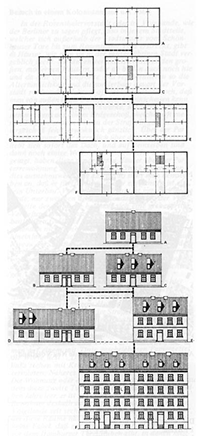
Fig. 1:
Schematic layouts and elevations for the development of the colonists' house
(Skoda 1968: n.n.)

Fig. 2:
Apartment house using the gridiron standard 25-by-100-foot lot and six stories,
E 21st St., New York City, 1878, by Bruce Price
(Plunz 1990: 65)
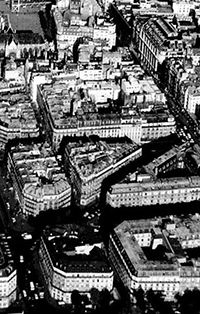
Fig. 3:
Typical second empire parceling in Paris at Victoria Avenue
(Pinon 2002: 85)

Fig. 4:
Layouts and elevations, Ackerstraße, Berlin, 1825-83
(Geist et al. 1984: 218)
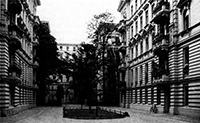
Fig. 5:
Riehmers Hofgarten, Berlin, 1891-99 Riehmers Hofgarten, Berlin, 1891-99,
by O. Moes and W. Riehmer
(Berning et al. 1990:68)
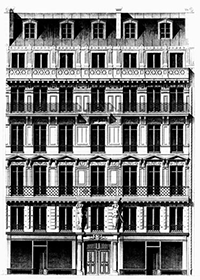
Fig. 6:
Immeuble haussmannien, Rue de la Paix, Paris, c.1864
(Pinon 2002: 133)
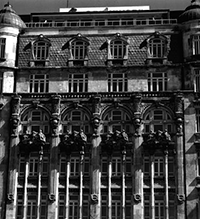
Fig. 7:
Frej Apartmani, Iskender Caddesi, Istanbul, 1905, by K. Kyriakidis
(Barillari et al. 1996: 151)
Until nowadays the Great City of the mid and late 19th century plays an important role in the discussion of contemporary urban planning and design – not only in terms of dealing with the huge amount of buildings and whole urban areas produced at that time. Apparently the 'Compact European City', its mere form and its supposed 'urbanity' serves as an ideal or an image, which is often employed within actual urban design projects and competitions and favored by a lot of lay people. We encounter her in form of the multi-functional street block as well as in standardized building heights, traditional stone facades, re-introduction of streetcars, etc. Of course, we do trace back all these individual features to the times of the dramatic urban change within the industrial and bourgeois époque, however, are they constitutive elements to the Great City of that time or 'just' features amongst others. Looking into the historic development of the 19th century metropolis and after all into the mechanisms of how this metropolis was produced we soon disclose a somewhat ubiquitous urban element, which hardly existed before: the 'Apartment House Building'. This very new approach towards urban housing consisted not only in the fact that one building accommodated numerous users, but that these users belonged to different social classes and, eventually, that there were new types of ownership: rent and condominium. Purpose of this short paper is to initiate a new reflection of the phenomenon apartment house building, its origin, its impact on the city's form and socio-economical structure and, after all, the reasons for its success. Once talking about the 'Leitbild' of the 'Compact European City' and the re-construction of it, one ought to discuss the apartment house building as one of the definite constituents of the 19th century metropolis.
Housing in the pre-industrial age was hardly an autonomous urban function. It was thoroughly connected to the work the residents were involved in, disregarding profession as well as class and dependence: craftsmen lived in or at their workshops as merchants lived with their storage; employees were part of the household they were working for, consequently the masters were sharing their domiciles with their servants. Within this somewhat symbiotic living there was, if there was, only a rough distinction between functions and hardly privacy for most of the inhabitants. This predominant concept produced socially interwoven groups in locales that were possessed by the head of the group. Apart from this and hostels for aliens one finds small cabins for daytaller, which were not part of any dense labor relationships. They neither had enough financial means to possess an accommodation on their own nor were they taken into their employer's house being hired only for some days or hours. They had to rent their shelter, often resulting in existential troubles by insolvency or arbitrariness through the landlord, who was not subject to specific regulations or laws but to his particular ethics, beliefs, or simply gluttony.
The fundamental change from small-size craftsmanship to industrial production in factories in the mid 1800 not only destroyed the old social structuring of society by creating 'bourgeoisie' and 'working class', but made obsolete the former housing models. The functions of working and housing were separated sharply, after all due to the fact that the new manufacturing processes took place in locales, which were no longer suitable for dwelling. Neither new storage nor business locales could anymore suit for the accommodation of the collaborators due to size or bulk of the goods, modern work organization and the value of the equipment. With this separation there also started segregation within housing: The number of employees outgrew enormously the number of employers, which naturally were neither willing nor able to accommodate all their staff – in their own household and free of charge as it used to be. In addition, one encounters the distinct demand for the development of a home as a private retreat, provoked, one might say, by the repressive political situation in Western Europe, mainly after the futile liberal ambitions in the early and mid 19th century. This private realm was established in opposition to the public sphere, where the economically highly successful members of society as well as the working–man had no political or societal participation, and belonged exclusively to the close family (Reulecke 1997: 67ff.). The ongoing financial success of some employers granted the development of larger suburban villas for the rich, however, simultaneously called for affordable homes for the left over members of society within the city limits. For those, including white-collar employees and civil servants, the possession of one's own housing space got more and more out of reach. Yet, them having the same increasing demand for secluded housing space 'apart' from others, there had to be a fundamental change within the urban housing arrangements.
One coherent result, predominantly in the continental European and some North-American main cities, was the creation of 'apartments', which is a number of secluded housing units within one building to be sold separately or rented out. To illustrate this process one might refer to the so-called "Kolonie Neu-Voigtland", an area north of the royal residence Berlin, which was developed from the mid 18th century on to shelter mainly foreign craftsmen (Geist et al. 1980: 42ff) Due to the increasing number of workmen in the Prussian capital the common one story timber-framed colonists' houses got subdivided into two to three units and gradually transformed into a four to five story stone "family" house, which was accessed by a main staircase [Fig. 1]. This development, that fundamentally changed the housing concept from a vertical to a horizontal one took place at the turn of the 18th to the 19th century, however, changed radically the face of the city. Ultimately the houses of "Neu-Voigtland" accommodated no longer merely craftsmen but a variety of professions and a considerable societal range from lower classes to the upper middle class. Latest at the end of the 19th century one observes similar processes in every industrialized country, mainly resulting in the subdivision of existing layouts, increase of stories, and exchange of the building structures, but initially acknowledging the extant lots and somewhat bequeathing former typologies [Fig. 2]. Soon all over the city the buildings produced compact blocks, and streets and squares now were confined by continuous tall street walls. At the same time the seclusiveness of the apartment grew up to the single locking apartment door as well as to the independence from communal functions by private heating, water-closets, kitchens, and bathrooms as well as direct water and gas supply within the building or even within the apartments themselves. One finds these amenities obviously more often with high-quality apartments for the better-off than for the working class.
Yet, the latter predominantly caused the urban population explosion, supported by an ongoing migration from the countryside into the urban nuclei, or – in the case of North America – by an enormous immigration by European refugees and fortune seekers. The increasing demand of housing units for single families gave enormous pressure to the housing market, which soon gained as much importance as the real estate market, if not more. Evidently, this new market quickly drew attention of the bourgeois economy, promising formidable profits. This was due to the fact that at once established apartments soon yielded continuously rental income under the precondition of imbalanced supply and demand: One ought to remember the lack of inner city mass-transportation as well as the extant limitation of the cities' growth by fortifications and other military issues. As demonstrated before, the appeal of the apartment house reached almost all parts of the urban society, leading to a number of goodly roomy tenements. For middle and higher classes the new type of housing resembled the living "a l'hôtel", which used to be reserved to noble aliens and foreign traders in feudal times. Nevertheless, day-teller and working man remained in poor housing conditions declined by growing overcrowding of little space. Still, exactly these small apartments were more profitable for the house-lords, which could be rented out without much effort in furbishing and maintaining to a great number of people (Scheffler 1913: 30ff.). At this point, naturally, one has to mention the importance of the emergence of building and housing authorities and urban planning as a new discipline, which should deal with the economical, technical, and regulatory issues of the city's development. However, the newly introduced discipline merely regulated the minimum standards to deal with hygienic and safety issues (Ley 2003: 3f.). Soon the transformation of extant layouts and increase of stories were not enough to meet the minimum housing needs of the customers, nor the economical ambitions of the contractors. Annexes and additional buildings got built, up to a 90% utilization of lots, for instance within the Commissioner's gridiron in New York City (Plunz 1990: 13ff.). In every Western city one finds the development of side-wings and rear buildings – in the housing development in Germany often euphemistically called garden-wings: there was hardly any garden left [see also fig. 4]. From the 1860s on larger developments got built, comprising numerous apartments accessed by small courtyards and several stairwells; these, of course, were made possible only where builders had influence on a new parceling.
Regarding this background one understands the sudden introduction of larger lots with the development of new housing estates outside the city limits (for instance the Hobrecht plan in Berlin 1862) and the grouping or re-arrangement of inner-city parcels (dramatically as with the Haussmann-Transformation of Paris from 1853 on, and incrementally in New York City by the joining of lots along the main Avenues). The real estate market had to follow the bourgeois demands, which resulted from the housing market. Simultaneously, the housing market got subdued to the same mechanisms the real estate market had developed, after all an enormous speculation and maximization of profits. The whole process of further urbanization assimilated to a 'production of cities', streets, lots, buildings and subsequently apartments became primarily a negotiable good (Fehl 1992). Often enough civil authorities stepped out and left the course of action to single builders and stock corporations. The result were vast areas of similar housing estates with optimized ground and story utilization due to the little building regulation there was and the technical building potentials developed [Fig. 3]. However, to stabilize the earnings of the bourgeois investment one meets within the apartment house buildings repeatedly a blend of tenants of diverse financial background, located in different parts of the building. The French 'maison mixte' developed a social classification by floor, in which the 'bel étage' is assigned to the financially most strong and socially esteemed; the higher stories were allotted recognizing the decreasing reputation towards the roof-top [see also the figure with the abstract: Étages du monde parisiens, 1845, lithography by Lavielle (Benevolo 1983: 849]. The Berlin 'Mietskaserne' and the 'Zinshäuser' in Vienna produced a primary segregation due to the distance towards the street; the number of backyards demonstrated easily stand and income of the inhabitants and at the same time justified the development of very deep lots [Fig. 4].
The ongoing optimization of lot- and story-utilization (most apartment houses had Mansard-roofs to accommodate tenants even there) sort of naturally developed optimized floor layouts as well. All over Paris, Berlin, New York, and Vienna one finds similar architectonical types, in which the tenants' needs had to fit in with hardly any room for individuality: the bourgeois 'bel étages' featured salons to the front and kitchens encircled by various service rooms and the servants' accommodations in the back; the work men's apartments had central living rooms most often incorporating the kitchen and sharing a water-closet on the stairwell or in the back-yard. Yet, this standardization easily enabled change of place within the city, as well as the urban society more and more enabled social bettering and worsening. The location of the apartment house, of course, played another important role; as before some quarters represented 'better quarters' than others, however, soon one finds whole new estates built for a specific clientele, yet showing similar segregation features though at a smaller range [Fig. 5]. Within this new system, the change of apartments developed as a fast expression of individual success or failure. The same way the industrial society could be defined by the dramatic migrations into the urban nuclei and between them (Köllmann 1974: 141), one encounters the urban man as a new kind of nomad, moving from one societal and locally fixed apartment to another, thus epitomizing all the chances the new urban life offered to its members. Unsurprisingly, the apartment house as a building type left little room for artistic expression but the facades (Scheffler 1913: 33ff.). The 'façadism' as another component of the impact of the apartment house onto the city's face can be observed all over and soon stood 'pars pro toto' for the Western metropolis – today being part of various art-historical examinations of the Belle Époque [Fig. 6 and fig. 7].
Yet, the success of the apartment house is not primarily an architectural one, but derives from the balance of the demands and needs of the urban inhabitants, which ultimately adjusted themselves to the new liberal, industrialized and modern age. The principles of the new housing economy produced a dense social mix within and an impressing coherent architectural body of the city. Eventually customer rights and civic regulatory called for improving standards also for the less well-to-do. As one can understand from the development of the apartment house building, it is a very constituent of the Western metropolis, exemplifying best the results of the fundamental societal change after the political and industrial revolutions in the bourgeois époque, which eventually became a metropolitan époque. The subsequent urban inventions of the early 20th century merely elaborated this habit of the Great City of the 19th century. Until nowadays the concept of the apartment house proofed an enormous flexibility, which still results in the formal standardization and affordability. Yet, we have to recognize that since then the Western urban societies and the cities have undergone several drastic changes, such as destruction, sprawl, and segregation; however, we will still benefit from the apartment house building and ought to remember the 'maison mixte' as a very urban element and possible strategy for the cities of tomorrow.References:
Barillari, Diana & Ezio Godoli 1996: Istanbul 1900. Art Nouveau Architecture and Interiors. New York NY : Rizzoli (Orig. Ed. [I] 1996 "Istanbul 1900. Architettura e Interni Art Nouveau"; Firenze : Octavo)
Benevolo, Leonardo 1983: Die Geschichte der Stadt. Frankfurt am Main / New York NY : Campus (7. Ed. 1993; Orig. Ed. [I] 1975/ rev. 1982 "Storia della città"; Roma : Laterza; transl. by Jürgen Humburg)
Berning, Maria, Michael Braum, Jens Giesecke, Engelbert Lütke Daldrup, & Klaus-Dieter Schulz 1990: Berliner Wohnquartiere. Ein Führer durch 70 Siedlungen
Berlin : Reimer (3. Ed. 2003)
Fehl, Gerhard 1992: Planungstheorie als "Theorie der Produktion der Stadt"
In: Reuter, Wolf (ed.): Entwurfs- und Planungswissenschaften - in memoriam Horst Rittel, pg. 29-37.
Stuttgart : Universität Stuttgart - Grundlagen der Planung
Geist, Johann F. & Klaus Kürvers 1980: Das Berliner Mietshaus. 1740-1862. München : Prestel
Geist, Johann F. & Klaus Kürvers 1984: Das Berliner Mietshaus. 1862-1945.
München : Prestel
Köllmann, Wolfgang 1974: Bevölkerung in der industriellen Revolution. Studien zur Bevölkerungsgeschichte Deutschlands. Göttingen : Vandenhoeck&Ruprecht
Ley, Karsten 2003: Il pensiero urbanistico in Germania: trattati e formazione disciplinare alla fine del XIX secolo. In: Bollettino del Dipartimento di Urbanistica e Pianificazione del Territorio, 1-2, pg. 3-12
Lichtenberger, Elisabeth 2002: Die Stadt. Von der Polis zur Metropolis
Darmstadt : Wiss. Buchges.
Pinon, Pierre 2002: Atlas du Paris Haussmann. La ville en héritage du Second Empire à nos jours. Paris : Parigramme
Plunz, Richard 1990: A History of Housing in New York City. Dwelling Type and Social Change in the American Metropolis. New York NY : Columbia Univ. Pr.
Reulecke, Jürgen 1997: Geschichte des Wohnens. 1800-1918. Das bürgerliche Zeitalter. Stuttgart : DVA
Scheffler, Karl 1913: Die Architektur der Gross-Stadt. Berlin : Cassirer (Repr. Ed. 1998; Berlin : Gebr. Mann)
Skoda, Rudolf 1968: Wohnhäuser und Wohnverhältnisse der Stadtarmut. Dargestellt insbesondere an der Rosenthaler Vorstadt von Berlin zwischen 1750 und 1850. Weimar : HAB
Ley, Karsten 2005
The 'Maison Mixte' and the great cities of the 19th century : the apartment house building as a constituent for the emergence of the Western Metropolis.
In: cities – grand bazaar of architectureS; [UIA 2005 Istanbul Congress] / [Abstracts and Academic Contributions of the XXII World Congress of Architecture Istanbul, 3-7 July, 2005] / Özkan, Suha [u.a.] Hrsg. - Istanbul : UIA. - S. 166; ID 471 CDrom-Ausg.
Publikationsserver der RWTH Aachen University [Elektronische Ressource]